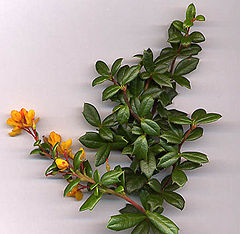- Berberis darwinii
-
Berberis darwinii 
Foliage and flowers Scientific classification Kingdom: Plantae Division: Magnoliophyta Class: Magnoliopsida Order: Ranunculales Family: Berberidaceae Genus: Berberis Species: B. darwinii Binomial name Berberis darwinii
Hook.Berberis darwinii is a species of barberry in the family Berberidaceae,[1] native to southern South America in southern Chile and Argentina. Common names include Darwin's Barberry and (Argentinean-Chilean Spanish) Michay.
It is an evergreen thorny shrub growing to 3–4 m tall, with dense branches from ground level. The leaves are small oval, 12–25 mm long and 5–12 mm broad, with a spiny margin; they are borne in clusters of 2–5 together, subtended by a three-branched spine 2–4 mm long. The flowers are orange, 4–5 mm long, produced in dense racemes 2–7 cm long in spring. The fruit is a small purple-black berry 4–7 mm diameter, ripening in summer.
B. darwinii was discovered (in Western science) in South America in 1835 by Charles Darwin during the voyage of the 'Beagle'; however, the berries of this species were consumed by prehistoric native peoples[2] in the Patagonian region over millennia. The species was one of many named in honour of Darwin.[3]
It is a popular garden and hedging shrub in the British Isles. The Royal Horticultural Society has given the species its Award of Garden Merit. The edible fruit is very acidic.
B. darwinii is regarded as an invasive plant pest in New Zealand[4] that escaped from gardens into indigenous plant communities via its bird-dispersed seeds.[5] It is considered a serious threat to indigenous ecosystems throughout New Zealand[6] and is listed on the National Pest Plant Accord.
References
- ^ Chilebosque: Berberis darwinii [1] Retrieved Aug. 2008
- ^ C.Michael Hogan (2008) Cueva del Milodon, The Megalithic Portal, ed. A. Burnham [2]
- ^ New York Academy of Sciences, Annals of the New York Academy of Sciences, Published by The Academy, 1909
- ^ Darwin's barberry, Containment pest plants, Greater Wellington Regional Council website, retrieved 12 January 2009.
- ^ Darwin’s barberry, DOC's weed work, Departm,ent of Conservation website, retrieved 12 January 2009.
- ^ Seedling Recruitment of the Invasive Species Berberis Darwinii (Darwin's Barberry): What Contributes to Invasion Success?, McAlpine, Katherine (Kate) Grace, 2005, Victoria University of Wellington doctoral thesis, retrieved 12 January 2009.
Categories:- Berberis
- Flora of Argentina
- Flora of Chile
- Garden plants of South America
Wikimedia Foundation. 2010.
